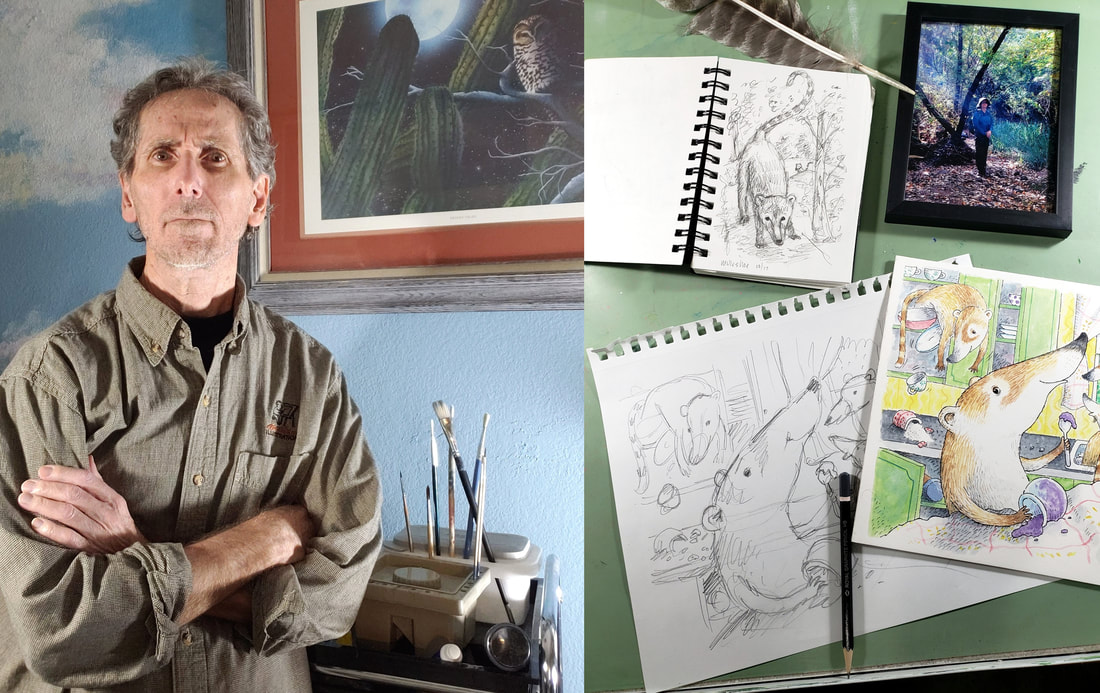On an absolutely beautiful and carefree Arizona autumn day in October 2017, my wife and I spent the day hiking. While hiking, we happened upon a large band of coatimundi mothers and babies foraging and playing among the cottonwood and sycamore trees. The experience can only be described as magical as we watched the mothers and young coatis romp around in the trees and grass. It was a sight straight out of a nature documentary. We wouldn’t have been surprised to see David Attenborough step out from behind a tree and start narrating the scene.
It was another grand adventure, just like so many others we had shared during our nearly 40 years of marriage.
On the hike back, there was chatter about plans for future hikes and adventures and discussions about animals, plants and rocks (our daughter was just starting on her master’s degree in geoscience.) We also talked about an idea I had for a children’s picture book about some mischievous coatis. (I’m a freelance illustrator and my wife was a writer and educator.) And we shared ideas for trips to the national parks we would like to visit and volunteer at. Mostly, there was talk about just living the good and simple life as we grew older together.
But on the hike back that day, my wife started feeling discomfort in her right arm pit.
A couple weeks later we were sitting in a breast clinic examination room together. In my hand was a gene sequencing report that I had just received from a relative of my wife. That report, dated May 2010, noted a deleterious BRCA2 gene mutation and that other family members had a “one-in-two chance of having the mutation.”
For seven years, that report sat unshared with my wife and her siblings. It was only shared after I started digging into my wife’s family’s cancer history in advance of her appointment. And her family’s cancer history turned out to be more devastating than I knew.
It is heartbreaking and difficult to understand how and why a family with multiple cancers – pancreatic, liver, breast, melanoma, and non-Hodgkin’s Lymphoma — and numerous cancer deaths spread over three generations avoided talking about the subject. It’s also very hard to understand why the doctors and genetic counselors that ordered that genetic test did not strongly and persistently encourage testing of other family members. Or at least encourage honest and open communication about the mutation.
After seeing the report, my wife was immediately referred for genetic testing by her doctor. A couple weeks later she tested positive for the same pathogenic BRCA2 variant as her relative and was diagnosed with Hereditary Breast and Ovarian Cancer Syndrome. A short time after that, our 24-year-old daughter tested positive for the same mutation as well.
In early December, my wife began chemotherapy for stage 3 triple-negative breast cancer. But not long after starting treatment, she developed severe back pain. An MRI revealed that the cancer had already metastasized to her spine. On Christmas Eve she was told she had stage 4 cancer and that treatment was now just palliative. In a span of only two months, we had gone from the hopes and dreams of a bright future to just hoping for a miracle. Hereditary cancer had changed everything.
On June 26, 2021, after what can only be described as a nightmare cancer journey through the darkest regions of hell, my wife took her last breaths as I embraced her. Losing my soul mate, adventure companion, co-creator and muse was unbearable and I wasn’t sure I would survive her death. But I had a grieving daughter about to have prophylactic surgery due to her own BRCA2 mutation in a couple of months. I had to be there for her. That’s when I vowed that I would become a hereditary cancer prevention advocate. I would do it for my previvor daughter and in honor of my late wife.
Because a gene sequencing report was not shared, and because my wife’s doctors failed to take note of her family’s cancer history, my wife suffered terribly. I want to try and keep others from suffering like my wife did. So I’m sharing my wife’s story and speaking up about the importance of genetic testing and family communication and the sharing of information when there is a history of cancer. Nobody should die of a preventable cancer. Nobody!




